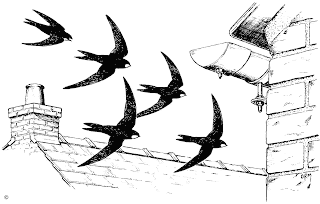Posted by Jake Allsop:
If we are going to protect existing Swift colonies, we need to know where they are and how many breeding pairs there are. Easier said than done! It's not difficult to locate a Swift colony, the giveaway is the screaming parties round the chimney pots (If the Swifts are very high, they are feeding, and not necessarily associated with nearby buildings). A further clue is the way prospecting birds will swoop towards, and often "bang" against, potential nest cavities under eaves or tiles, or against crevices in brickwork.
The next step is to assess the size of the colony. Counting parties of swirling Swifts is no easy matter - they break up into smaller parties and constantly swoop away out of sight. A good tactic is to find one or more high vantage points, so you can assess the same flock from different angles. Even then your total is unlikely to be accurate, but it's better than no total at all. Finally - and this is where every Swift enthusiast tears his/her hair out - you want to know how many breeding pairs there are.
Not all Swifts entering a nest cavity are breeders; some will be non-breeders checking out a potential home for the following season. There are clues, but all are either difficult to see, or give probable rather than confirmed breeding. When a parent with food flies up to the nest cavity, you might be lucky enough to see the huge bulge of its insect-laden crop. More often you won't! Another clue, useful also after the birds have departed, is some faecal splashing, just below the nest entrance or on the ground below.The splashing will usually be minimal and streaky; if it's copious, the droppings are more likely to be Starling or House Sparrow. If your hearing is acute, you might be able to hear chicks calling in the nest.
But, to be honest, it's virtually impossible to get an accurate picture of numbers of breeding pairs. However it may be possible to make an intelligent guess at a colony size. Early in the season when the birds arrive, neither bird spends much time in the nest. Then they lay some eggs and there is always one bird in the nest and one bird flying around feeding (both sexes incubate, so either sex could be flying around) , then, after the chicks get to a certain size, both birds are flying around feeding. In the back half of July, before the birds go to roost, especially on warm, balmy evenings, they are all flying around above the colony. So, if you see a stable flock of, say, 20 birds flying above a colony, the size of the colony is somewhere between 10 and 20 pairs. Depending on when you see them one can make a guess as to whether it is nearer to 10 or 20. Of course, this is all complicated by the number of non-breeders around, and the number of breeders that are away feeding somewhere. Another case of "we need more data" to refine this technique
If nothing else, there is great pleasure to be derived from watching Swifts at a colony. Any information gathered thereby is worthwhile. You can send yours to the RSPB Swift Survey.


Happily we've had 30-40 swifts screaming overhead for the last week. We live in the university area of Reading, and they seem to gather over straight over our garden maybe because it has some big trees and a pond. In the previous weeks when the weather wasn't so good, there seemed to be about ten around. Is this massing now preparation for migration since we are in the last week of July I wonder?
ReplyDeleteThis nice weather has given swifts the chance to spend some time enjoying themselves and for prospecting birds to look for new nest sites. During the long wet summer, the priority was finding food. Dick
Delete